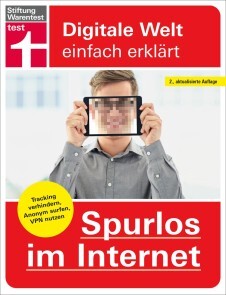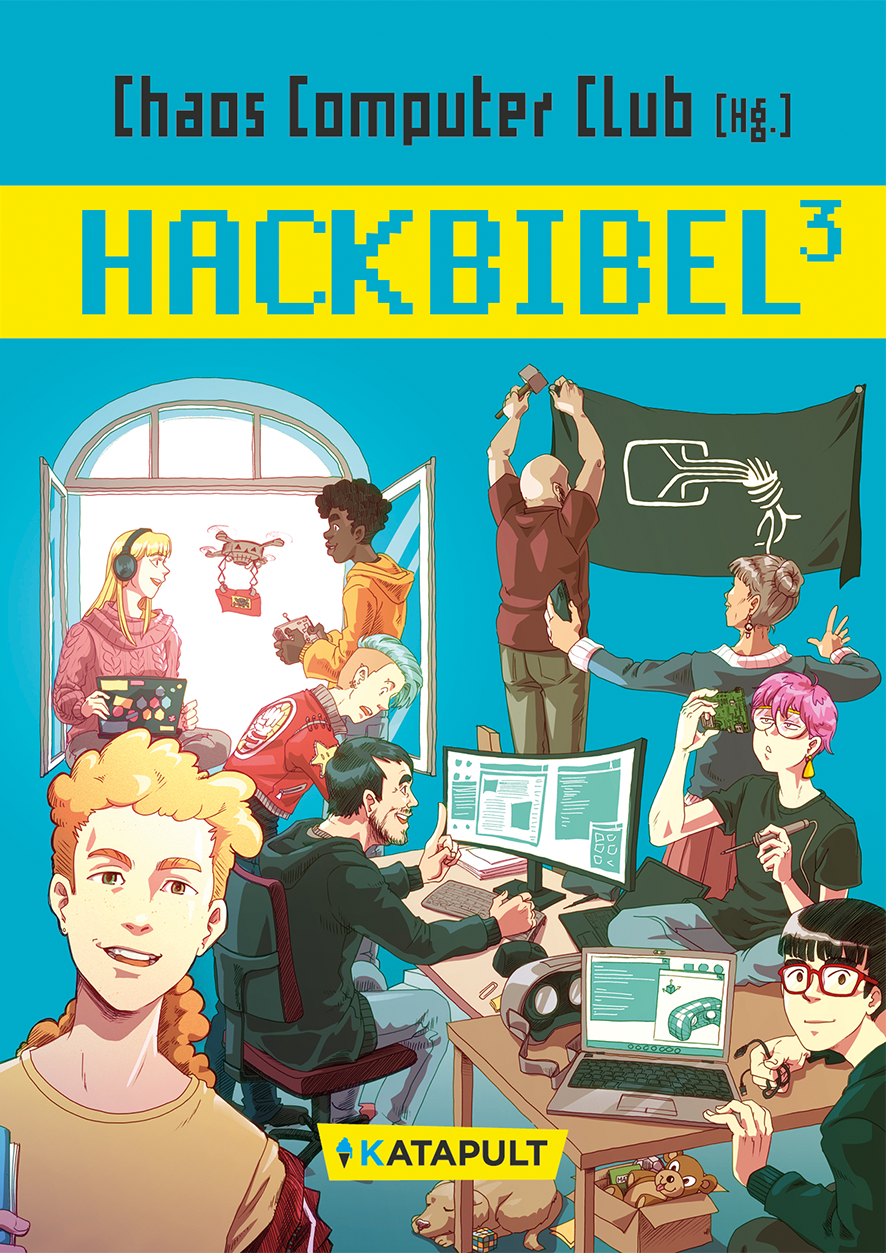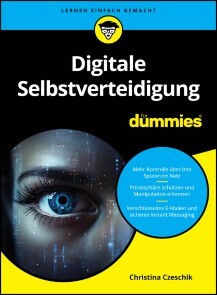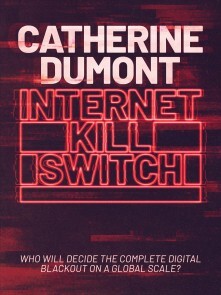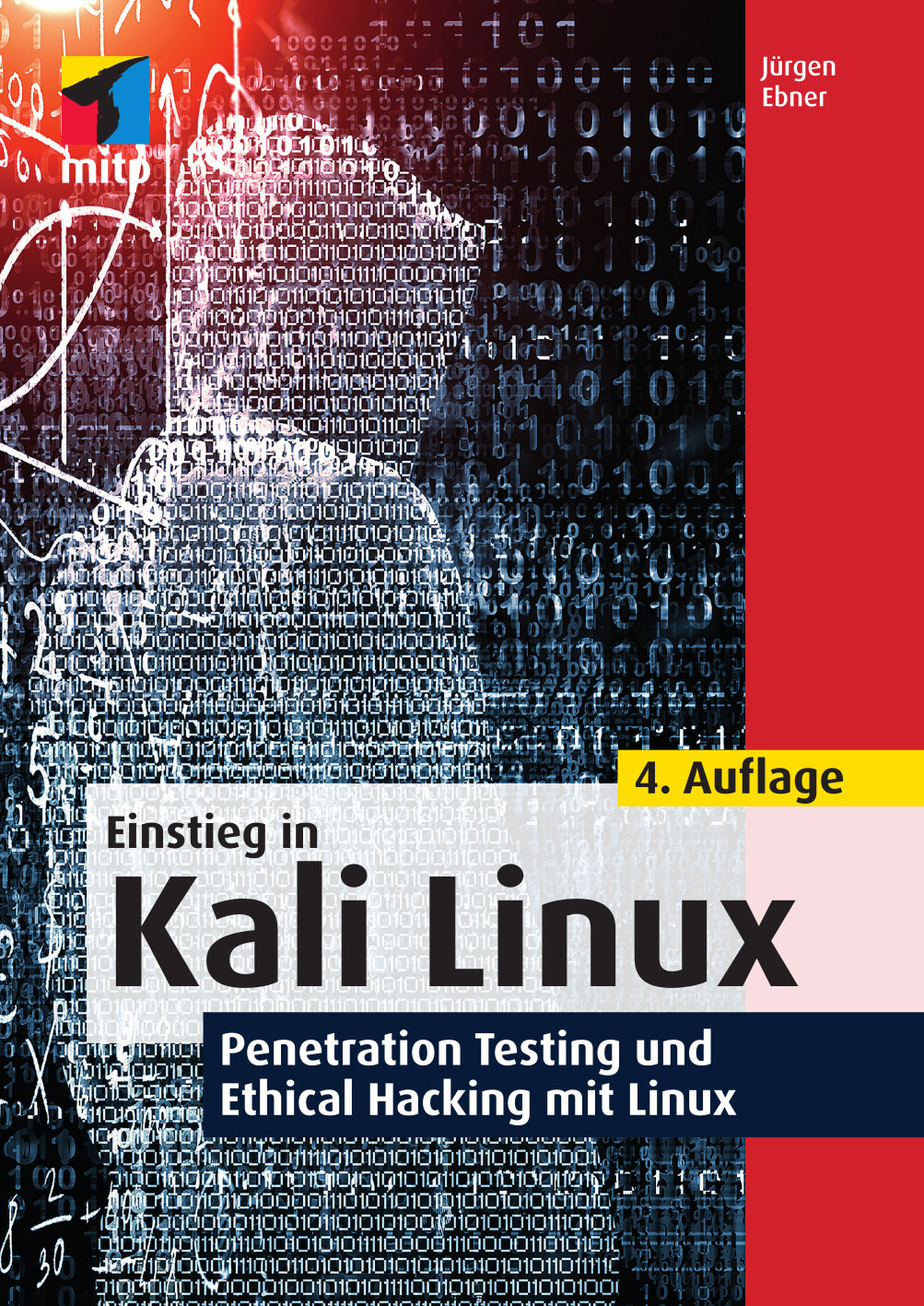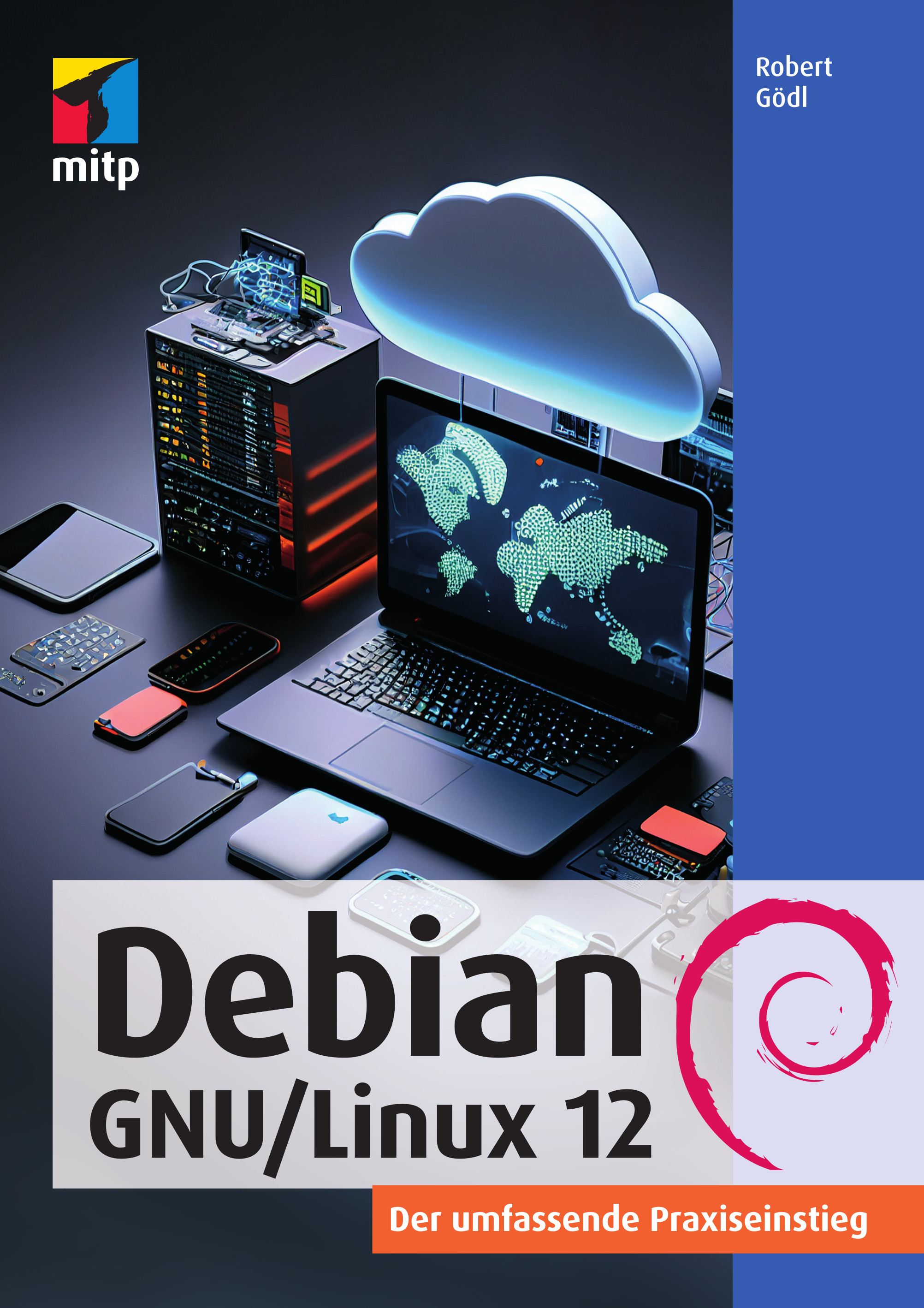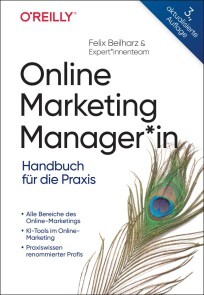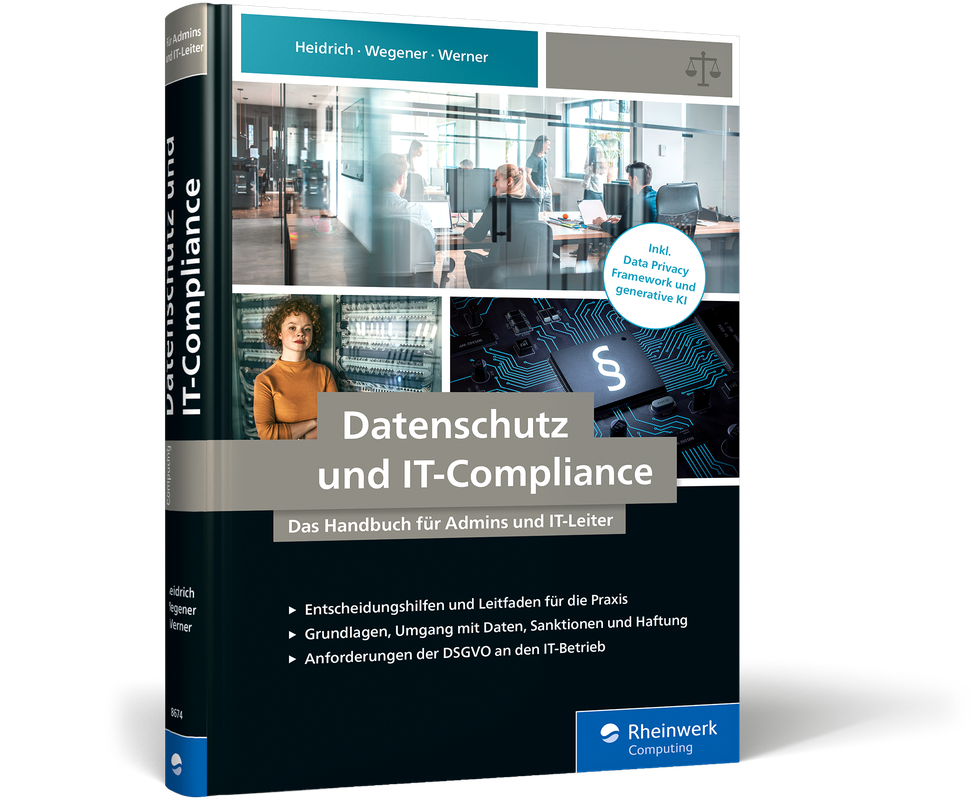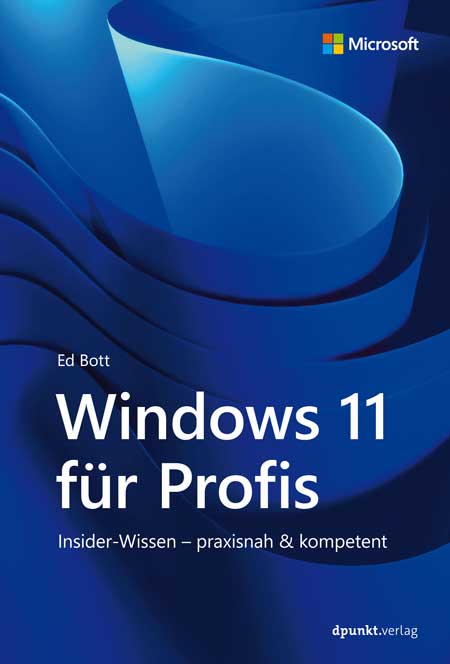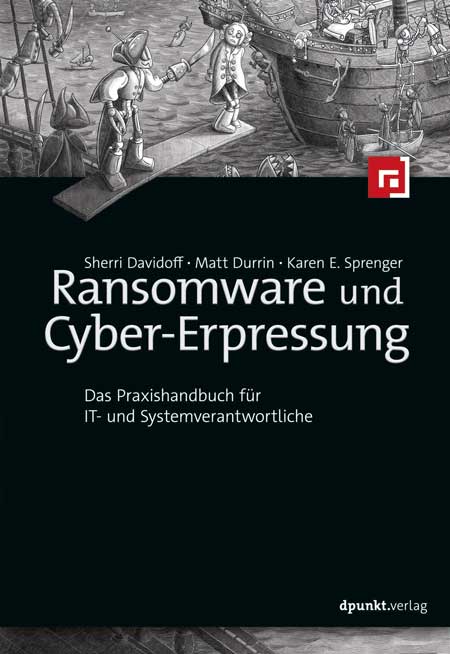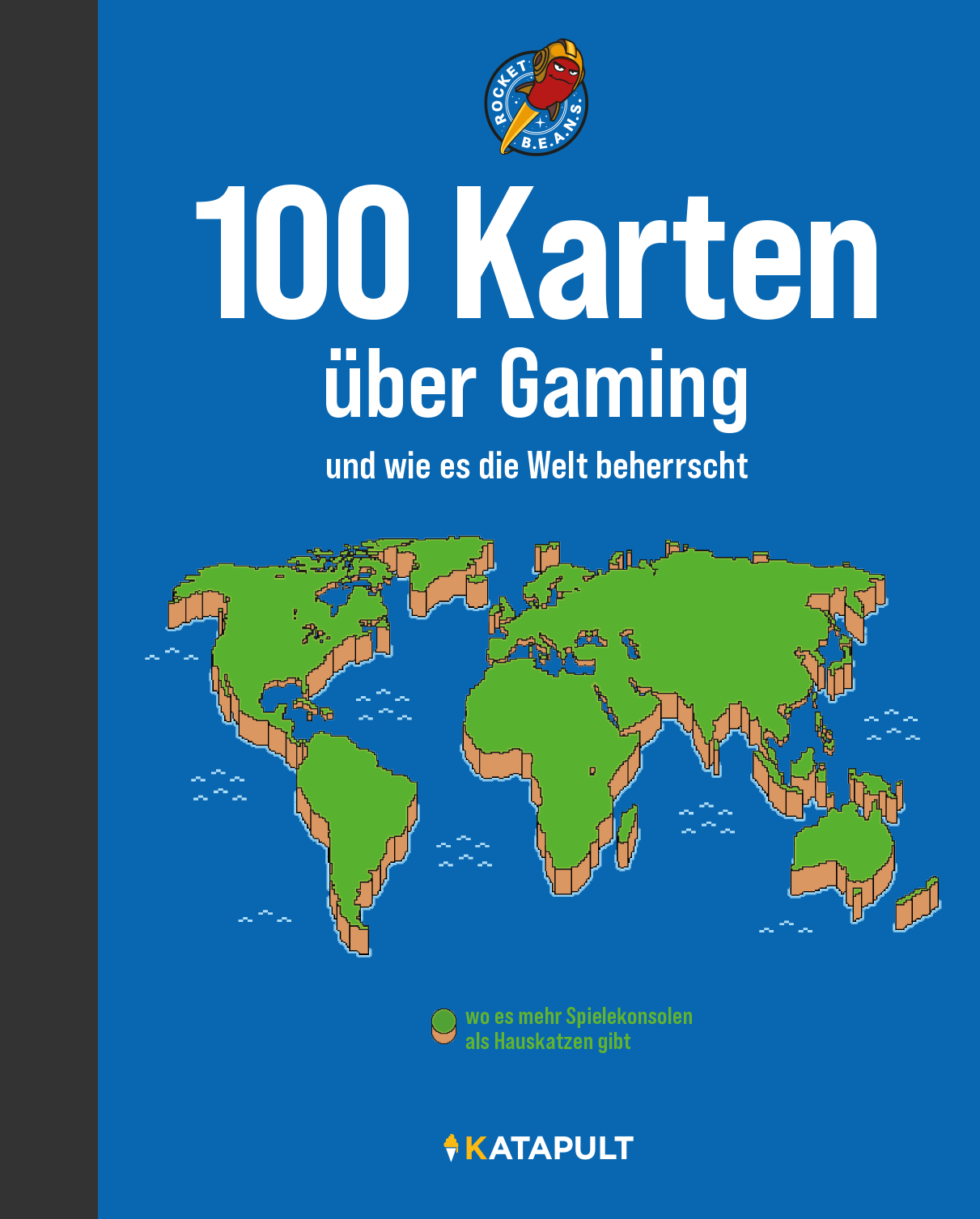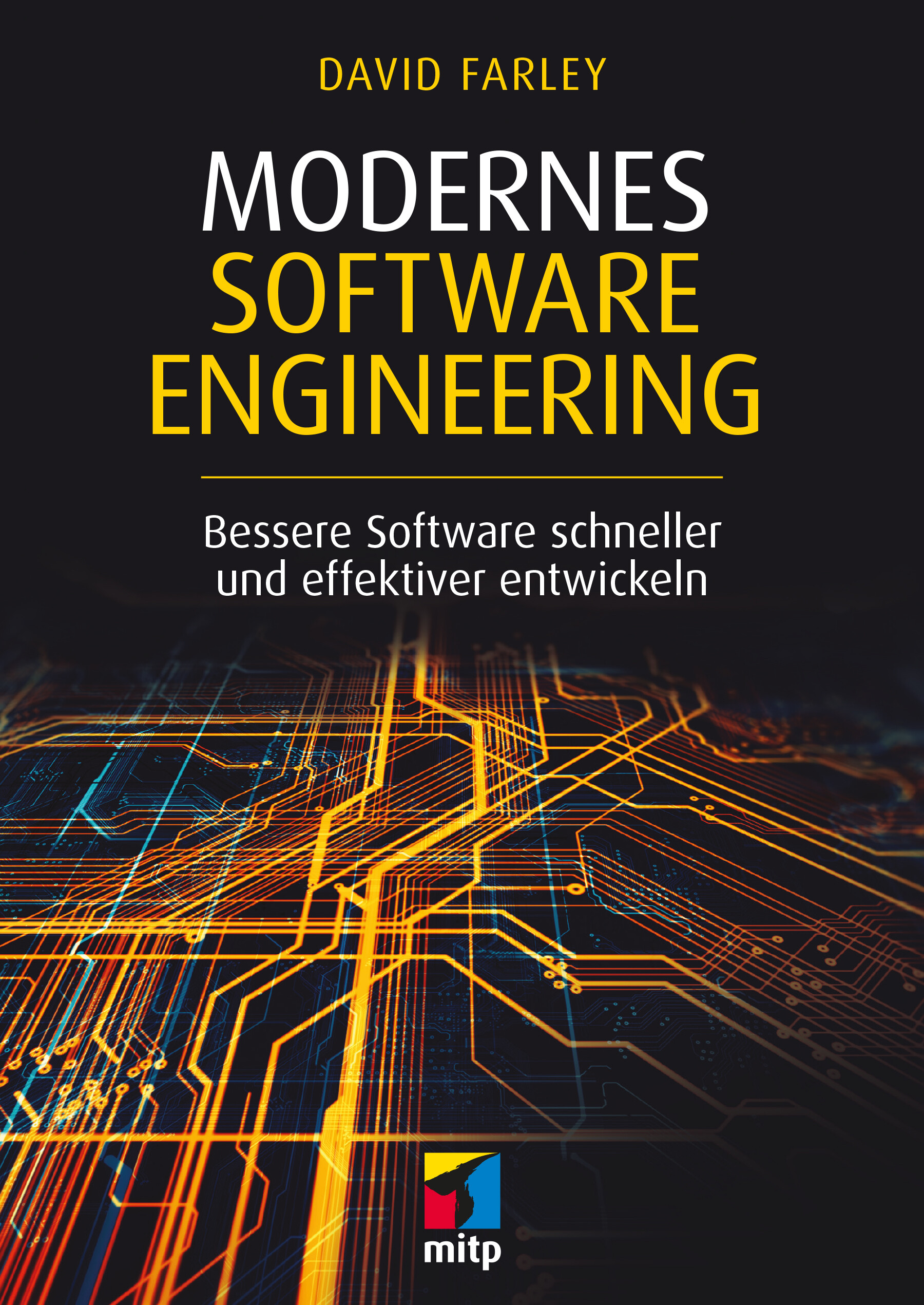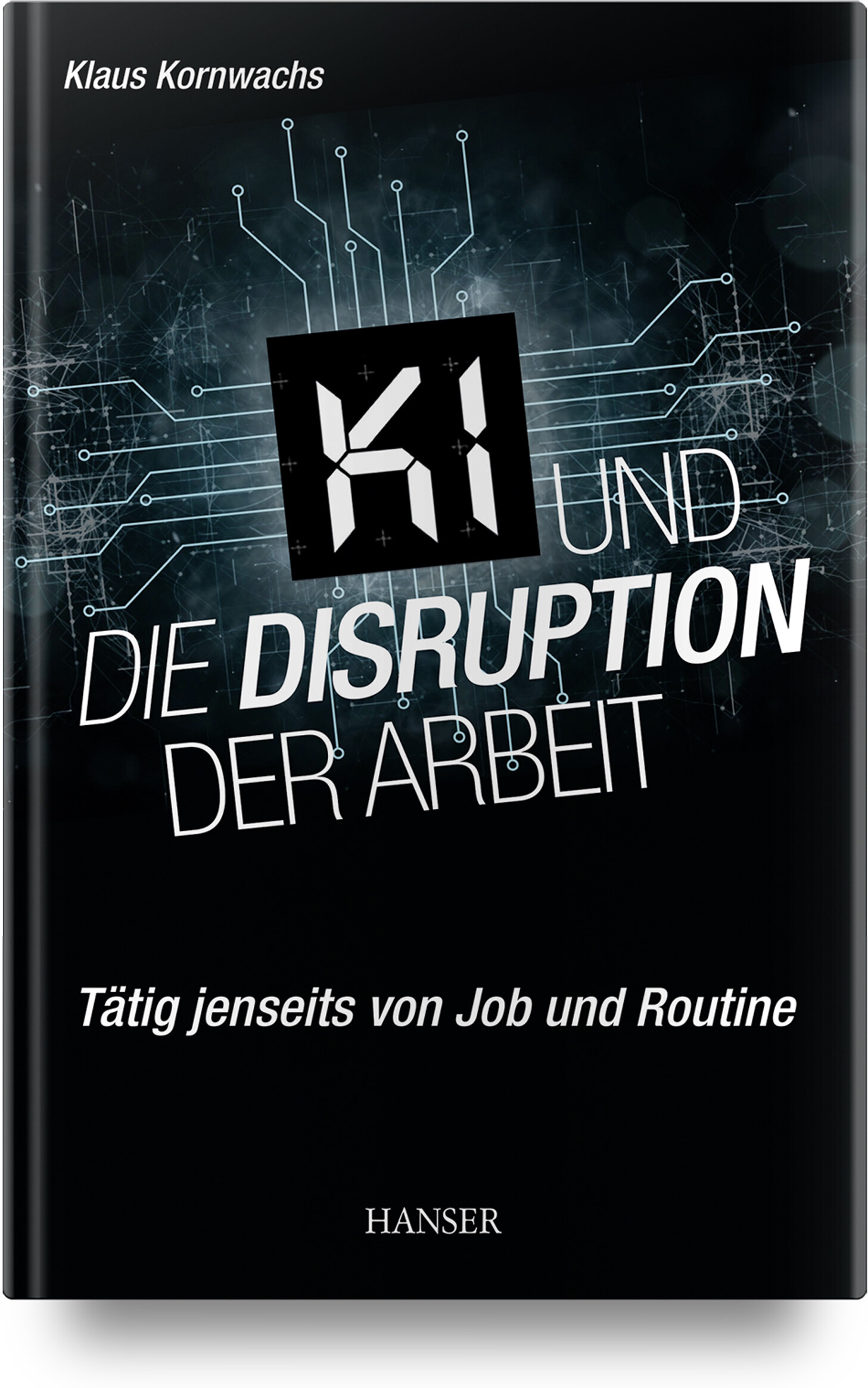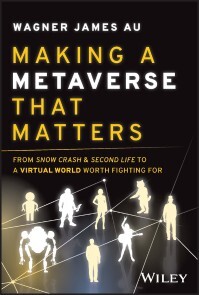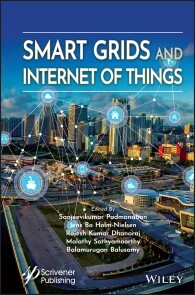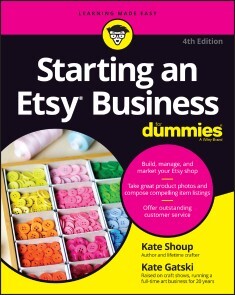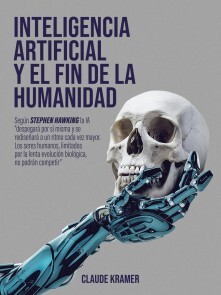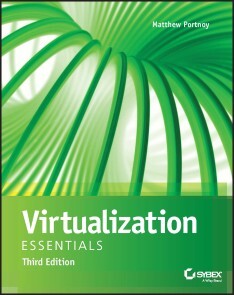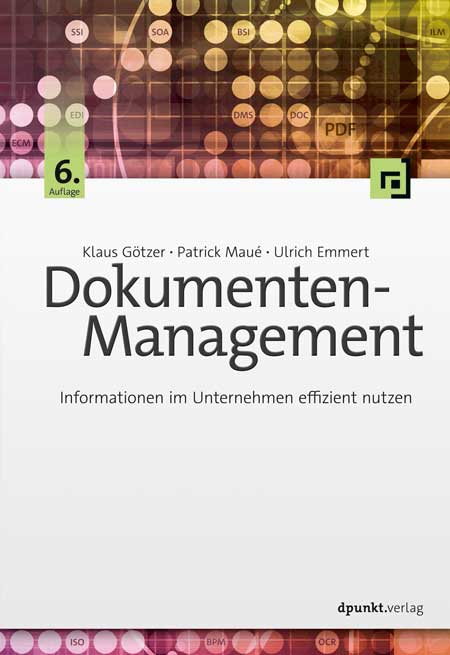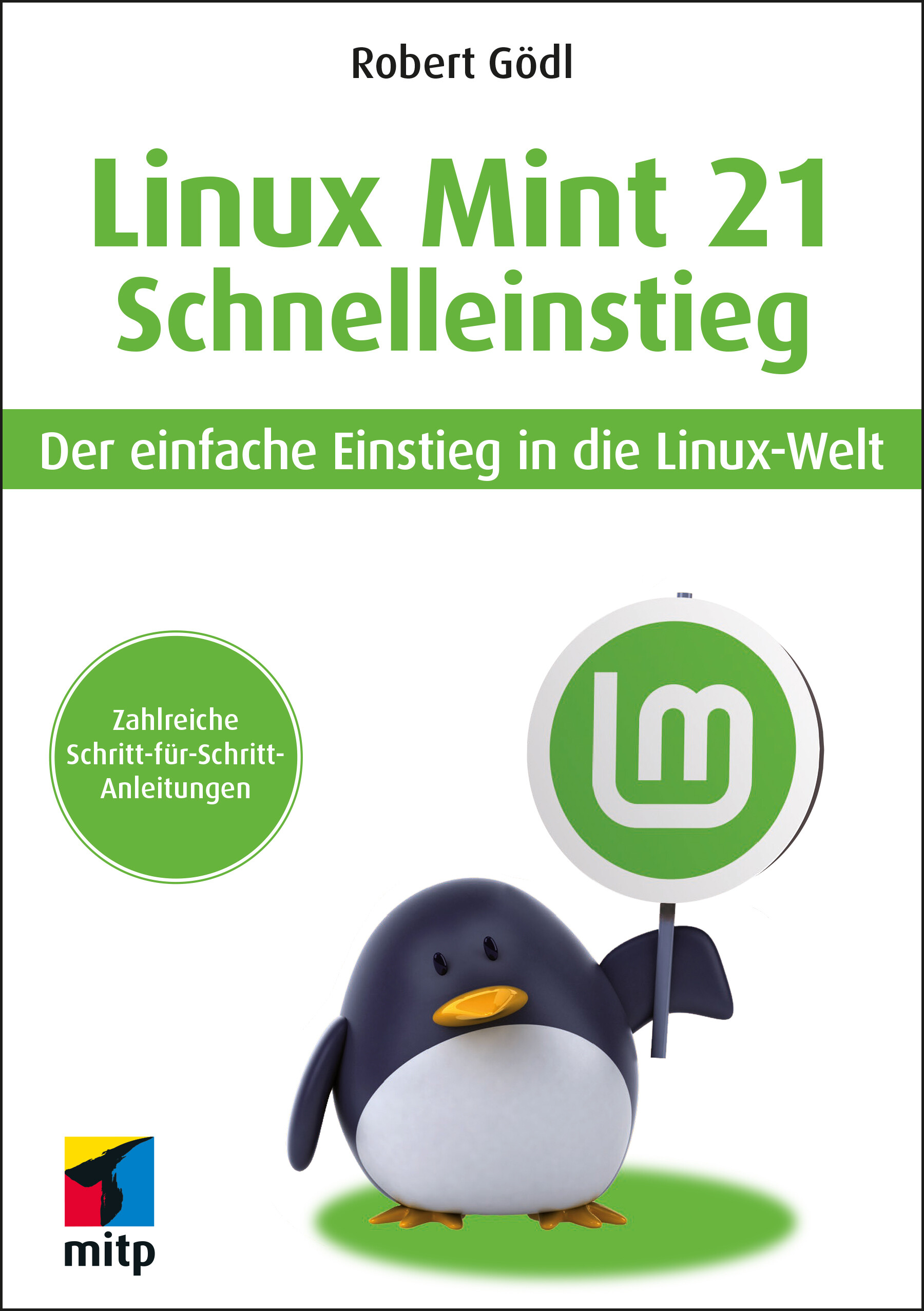Netzpolitik & Belletristik
Neu
Alle Daten sicher
15,99 €*
Es kann jeden treffen: eine defekte Festplatte, ein Wohnungsbrand, ein Virus oder ein kaputtes Smartphone. Weg sind dann Daten wie die Abschlussarbeit, persönliche Dokumente oder gar sämtliche private Fotos. Wie können wir unsere wichtigsten Daten bestmöglich schützen? Von Backup-Software über Passwortmanager bis hin zu Antivirenprogrammen stellt Ihnen dieser Ratgeber bewährte Tools und Schutzmaßnahmen basierend auf den Untersuchungen der Stiftung Warentest vor. Wichtig ist nicht zuletzt auch umsichtiges Verhalten wie das regelmäßige Durchführen von Software-Updates oder das anonyme und sichere Surfen in öffentlichen Netzen. Und sollte doch einmal der Worst Case eintreten, gibt es auch dafür Lösungen, die das Buch für Sie bereithält.Andreas Erle ist Autor zahlreicher Bücher, Zeitschriften- und Onlineartikel rund um die Themen Windows, Smartphone und mobiles Internet, zu denen er auch eine umfangreiche Webseite betreibt. Im Buchprogramm der Stiftung Warentest sind von ihm unter anderem die Ratgeber "Windows 11" sowie "Spurlos im Internet" erschienen.Ihre Daten – Ihr Schatz!- Daten sind wertvoll- Warum digitalisieren?- Digitalisieren – aber wie?- Digitalisieren mit dem Smartphone- Digitalisiert – und nun?- Den Datenschatz aufbauen – mit Sinn und VerstandSo behalten Sie den Überblick- Wo liegen überall Daten?- Daten auf dem Smartphone- Daten auf anderen Geräten- Dateien suchen und finden- Ordnung ist alles: Die StrukturAlles kann passieren!- Malware – die (un)bekannte Gefahr- Ransomware – Erpresseralarm!- Phishing – perfekte Fälschung- Die Zeit und andere KatastrophenRisikobewusstes Verhalten im Alltag- Die drei Grundprinzipien- Vertraulichkeit schützen- Passwörter: Trügerischer Schutz- Verfügbarkeit und Integrität sicherstellen- Oft vergessen: Das Internet der DingeGut gesichert und geschützt- Passwörter – komfortabel und zugleich sicher?- Die Internetverbindung- Der Browser- Rechner und Betriebssystem- Verschlüsselung als zusätzlicher Schutz- Wolkenschlösser: Die Cloud- Netzwerkfestplatten als Backup-Medium- Backups richtig erstellenSchon zu spät? Hilfe im Verlustfall- Verlorene Daten retten- Datenverlust an Fremde- Ausweis- und KartenverlustHilfe- Stichwortverzeichnis
Neu
Spurlos im Internet (2. Auflg.)
15,99 €*
Wer im Internet surft, hinterlässt Spuren. Wenn Sie eine Webseite aufrufen, online einkaufen, soziale Netzwerke nutzen oder Ihre Lieblingsserie streamen: All das gibt persönliche Informationen über Sie preis. Sie haben nichts zu verbergen? Sollten Sie aber. Was passiert mit diesen Daten? Was wissen Amazon, Google, Facebook & Co. über Sie? Welche Daten werden über Sie erhoben und wie können Sie deren Verbreitung eingrenzen? Dieser Ratgeber zeigt mithilfe verständlicher Anleitungen und vieler Screenshots, wie Sie Ihre digitalen Geräte sicher nutzen und ein Maximum an Privatsphäre schaffen. Sie erfahren, wie Sie starke Passwörter generieren, Ihre privaten Daten kontrollieren und löschen, wie Sie Webseiten-Tracking durch Cookies verhindern und wo datensparsamere Geräte Sinn ergeben. Denn Sie haben etwas zu verbergen – und das ist auch gut so!Andreas Erle ist Autor zahlreicher Bücher, Zeitschriften- und Onlineartikel rund um die Themen Windows, Smartphone und mobiles Internet, zu denen er auch eine umfangreiche Webseite betreibt. Im Buchprogramm der Stiftung Warentest sind von ihm bereits die Ratgeber "Windows 10", "Windows Supertricks" sowie "Spurlos im Internet" erschienen.Sie haben etwas zu verbergen!- Anonymität schafft Privatsphäre- Private Daten: Währung und Risiko- Der Super-GAU Datenleck- Wo sind Ihre Daten?Windows und Mac anonymer machen- Nutzen und Risiko abwägen- Ein Benutzerkonto anlegen- Wo liegen Ihre Dateien?- Das Passwort: Ein sicherer Schutz?- Ohne Updates geht es nicht- Verschlüsselung: Noch mehr Sicherheit- Die Spione in Ihrem Computer- Datensparsamkeit: Weniger ist mehr- Datenschutzeinstellungen kontrollierenAnonymer surfen- Augen auf im Internet- Sichere Benutzerkonten- Mittel gegen Tracking- Suchmaschinen: Es gibt nicht nur GoogleSozial, aber nicht öffentlich- Facebook und die Macht der Daten- Privatsphäreeinstellungen nutzen- Das Konto löschen- Die EU-DSGVO: Ihre Rechte- Big-Data-Nutzung zum Wohl der Allgemeinheit?Smartes Phone, gläserner Nutzer- Ein Gerät für alles- Mit dem Google-Konto unterwegs- Einstellungen auf dem Android-Smartphone- Einstellungen auf dem iPhoneDas Internet der Dinge- Die Datenlogger am Handgelenk- Wenn Sprachassistenten mithören- Anfälligkeiten und Schutz- Ein Blick in die Zukunft- Sie haben es in der Hand!Hilfe- Stichwortverzeichnis
Neu
Hackbibel 3
28,00 €*
Lange erwartet und nun endlich da – die Hackbibel 3. Sie führt die Tradition der Hackerbibeln aus den 80er-Jahren fort und erzählt Geschichten des Chaos Computer Clubs e. V. und der Hacker*innenkulturen.Seit seiner Gründung im Jahre 1981 hat sich der Chaos Computer Club stets in politisch-technische Debatten eingemischt. In diesen mehr als 40 Jahren ist viel passiert: Die Wiedervereinigung brachte Computerkulturen aus Ost und West zusammen, der Chaos Communication Congress ist riesig geworden, die Piratenpartei ist auf- und niedergegangen und feministische Hack-Gruppen haben sich gegründet. Die Hacker*innen programmierten nicht nur sichere Kommunikationswege und freizugängliche Software oder hackten Wahlcomputer und Fingerabdrücke von Politikern, sie zogen manchmal auch bis vors Bundesverfassungsgericht. Der CCC hat das Land entscheidend mitgeprägt.Davon erzählt die Hackbibel 3 und bietet Einblicke in Hacktivismus und Aktivismus, IT-Sicherheit und Recht und zeigt eine vielfältige, diverse Kultur, die sich durch Spaß am Gerät, an Basteleien und sehr viel Witz auszeichnet.Leseprobe (PDF-Link)
Digitale Selbstverteidigung für Dummies
15,99 €*
DER SCHWARZE GÜRTEL FÜR DAS NETZ Sie wollen Ihre Privatsphäre und Ihre digitale Identität schützen? Dabei hilft Ihnen dieses Buch. Christina Czeschik klärt Sie darüber auf, wo Sie welche Daten und Metadaten hinterlassen, und hilft Ihnen dann dabei, darüber die Kontrolle zu behalten und so digital selbstbestimmt zu sein. Konkret erklärt sie Ihnen, wie Sie den Schutz Ihrer Privatsphäre bei E-Mails, Chats, Videocalls, in sozialen Netzwerken, beim Einkaufen, Surfen und Streamen sicher stellen. Zudem wirft sie einen kritischen Blick auf Smartphones, Apps und zuletzt auch unsere eigenen Gewohnheiten rund um das Internet. SIE ERFAHREN* Was es mit dem Konzept der digitalen Souveränität auf sich hat* Wie Sie PGP und S/MIME für E-Mail-Verschlüsselung und digitale Signatur nutzen* Welche Einstellungen für bessere Privatsphäre Sie im Browser treffen können * Wie Sie mit Tor (fast) anonym browsen könnenDR. CHRISTINA CZESCHIK, M.SC., ist Ärztin und Medizininformatikerin. Seit 2015 ist sie freie Autorin und schreibt und bloggt über Digitalisierung, digitale Gesundheit, Informationssicherheit und digitale Privatsphäre. Unter dem Pseudonym Jo Koren schreibt sie Science-Fiction.
Internet Kill Switch
4,99 €*
The "Internet Kill Switch", as it is known worldwide, is a protective "countermeasure". It is the ability of governments to restrict or directly block access to the Internet: turn off all servers and connections. Considering all that the Internet entails in our daily lives, it is an extremely powerful weapon. Some consider it as a key tool for national security, allowing governments to respond immediately in times of crisis or cyber-attacks. Others fear a potential abuse of authority, claiming that it infringes on civil liberties and democratic values. Is it possible to implement this measure as a global reconfiguration, and why would it be done?Catherine Dumont is an author and historian. Named as Distinguished Professor of American Studies and History, her research interests include the construction of racial identity and class structures.1.WWW Reloaded2.The Button3.Cloud Backup4.Internet and Democratization5.Kill Switch at the Service of Censorship6.Kill Switch to Stop a Revolution7.Internet Blackout within the Laws8.From the Pandemic to the Cyberpandemic9.Kill Switch for a Great Reset10.The National Security Perspective
Neu
Einstieg in Kali Linux (4. Auflage)
33,00 €*
Einstieg in Kali Linux. Penetration Testing und Ethical Hacking mit Linux. 4. Auflage, Januar 2024.Die Distribution Kali Linux ist auf Sicherheits- und Penetrationstests spezialisiert. Sie enthält mehrere Hundert Pakete zur Informationssammlung und Schwachstellenanalyse und jede Menge Tools für Angriffe und Exploitation sowie Forensik und Reporting, sodass Penetration Tester aus einem beinahe endlosen Fundus kostenloser Tools schöpfen können. Dieses Buch ermöglicht IT-Sicherheitsexperten und allen, die es werden wollen, einen einfachen Einstieg in Kali Linux. Erfahrung im Umgang mit anderen Linux-Distributionen setzt der Autor dabei nicht voraus.Im ersten Teil des Buches erfahren Sie, wie Sie Kali Linux installieren und an Ihre Bedürfnisse anpassen. Darüber hinaus gibt Ihnen der Autor grundlegende Linux-Kenntnisse an die Hand, die Sie für das Penetration Testing mit Kali Linux brauchen.Der zweite Teil erläutert verschiedene Security Assessments sowie die grundlegende Vorgehensweise bei der Durchführung von Penetrationstests. So vorbereitet können Sie im nächsten Schritt gezielt die für Ihren Einsatzzweck passenden Tools für das Penetration Testing auswählen.Aus der Fülle der bei Kali Linux mitgelieferten Tools stellt der Autor im dritten Teil des Buches die wichtigsten vor und zeigt Schritt für Schritt, wie und wofür sie eingesetzt werden, darunter bekannte Tools wie Nmap, OpenVAS, Metasploit und John the Ripper.Nach der Lektüre sind Sie bereit, Kali Linux sowie die wichtigsten mitgelieferten Tools für Penetrationstests einzusetzen und IT-Systeme auf Schwachstellen zu prüfen.Aus dem Inhalt:Hauptfeatures und Richt-linien von Kali LinuxInstallation und KonfigurationLinux-Dateisystem, Kommandozeile und nützliche Linux-BefehleSicherheitsrichtlinienEinführung in Security AssessmentsDurchführung von PentestsInformationssammlungmit Nmap, TheHarvester, HTTrack u.v.m.Schwachstellenanalyse mit OpenVAS, Nikto und SiegeSniffing und Spoofing mit Dsniff, Ettercap und WiresharkTools für Attacken: Wireless-Attacken (aircrack-ng, Ghost Phisher, Kismet)Pentesting von Webseiten (WebScarab, Skipfish, ZAP)Exploitation (Metasploit, Armitage u.v.m.)Passwort-Angriffe (Medusa, JtR u.v.m.)IT-Forensik mit Autopsy, Binwalk und mehrReporting mit Cutycapt, Faraday und mehrCheckliste für PenetrationstestsPraktisches GlossarÜber den Autor:Jürgen Ebner ist u.a. IT-Techniker und zertifizierter Datenschutz- und IT-Security-Experte. Bei der IT-Betreuung setzt er auf proaktive Services, um für mehr Sicherheit in den Unternehmen zu sorgen. Mit seinem IT-Unternehmen ICTE bietet er neben Managed Services vor allem Security Assessments und die Erarbeitung von Datenschutzkonzepten an.Leseprobe und Inhaltsverzeichnis (PDF-Link)
Varianten ab 32,99 €*
Debian GNU/Linux 12
34,99 €*
Debian GNU/Linux. Der umfassende Praxiseinstieg. In Erstauflage aus Januar 2024.Debian ist eine stabile, langlebige und professionelle Linux-Distribution, die ein Höchstmaß an Anpassungsfreiheit bietet. Dieses Buch begleitet Sie von der Installation und der Konfiguration bis hin zum produktiven Einsatz – egal, ob Sie Linux-Neuling oder erfahrener Anwender sind.Sie lernen alle Grundlagen, die Sie brauchen, um Debian sowohl als klassisches Desktop-Betriebssystem als auch als leistungsstarken Server einzusetzen. Der Autor führt Sie durch die textbasierte Bedienung mit dem Terminal und zeigt Ihnen, wie Sie Ihr System vor Angriffen schützen und wie Sie es im Fall von technischen Fehlern oder Datenverlust wiederherstellen können. Auch weitere wichtige Aspekte der Systemadministration wie Software- und Firmwareupdates, die Prozessverwaltung mit Systemd und die Automatisierung mit Cron werden leicht verständlich erläutert.Mit diesem Buch können Sie Debian effektiv und professionell auf Ihrem Desktop oder Server einsetzen und das volle Potenzial dieser leistungsstarken Distribution nutzen.Aus dem Inhalt:Live-System und InstallationGrafische Oberflächen: KDE Plasma, GNOME und XFCEPaketverwaltung und AppImagesBenutzer und RechteverwaltungWichtigste Terminal-Befehlesystemd – die SteuerzentraleAutomatisierung mit CronNetzwerkkonfigurationMail- und DNS-ServerApache und MariaDBVirtualisierung mit DockerFirewall konfigurierenBackups und DatenrettungSystemwiederherstellungÜber den Autor:Robert Gödl ist überzeugter Linux-Nutzer mit einer Vorliebe für das Testen von freien Betriebssystemen und freier Software. Nach über 20 Jahren ohne Microsoft Windows möchte er anderen zeigen, dass Linux heute einfach zu installieren, zu nutzen und zu verstehen ist.Leseprobe und Inhaltsverzeichnis (PDF-Link)
Online Marketing Manager*in
31,99 €*
Online-Marketing ist vielfältig und dynamisch – und stellt Online Marketing Manager*innen stets vor neue Herausforderungen. Sie müssen in ganz verschiedenen Disziplinen über fundiertes Wissen verfügen, Strategien und Kampagnen erarbeiten und deren Wirksamkeit durch geeignete Kennzahlen überprüfen können. Es gehört zu ihren Aufgaben, unterschiedliche Kanäle mit zielgruppengerechtem Content zu bespielen und neue Entwicklungen stets im Blick zu haben – wie etwa den Einsatz von KI im Online-Marketing.Dieses Handbuch bietet wertvolles Grundlagenwissen, erklärt die relevanten Begriffe und Konzepte eines jeden Bereichs und veranschaulicht erprobte Best Practices und aktuelle Entwicklungen. Zwölf ausgewiesene Expertinnen und Experten vermitteln in diesem Ratgeber ihr über viele Jahre erworbenes Know-how.Ganz gleich, in welchem Bereich Sie aktiv sind oder in welches Gebiet Sie sich einarbeiten möchten: Dieser Bestseller gehört auf den Schreibtisch engagierter Online Marketing Manager*innen.- Status quo und aktuelle Entwicklungen | Felix Beilharz- Online-Marketing-Strategie | Olaf Kopp- Content-Marketing | Olaf Kopp- Conversion-Optimierung | Nils Kattau- SEO – Suchmaschinenoptimierung | Anke Probst - SEA – Search Engine Marketing | Guido Pelzer- Affiliate Marketing | Markus Kellermann- Display Advertising | Stephan Römer- E-Mail-Marketing | Manuela Meier- Social Media Marketing | Felix Beilharz- Mobile Marketing | Ingo Kamps- Digital Analytics | Markus Vollmert- Daten und KI im Online-Marketing | Tom Alby- Online-Marketing-Recht | Niklas Plutte- Weiterbildung | Felix BeilharzFelix Beilharz ist »einer der führenden Berater für Online- und Social Media Marketing« (RTL). Er »zählt zu den besten Rednern Deutschlands« (Westdeutsche Allgemeine Zeitung). Forbes bezeichnet ihn als »Germany'sDigital Marketing Rockstar«. Seit 2001 ist er im Online Marketing aktiv. Als Autor hat er 8 Bücher veröffentlicht, die es teilweise, für Fachbücher eine Seltenheit, in die Top 20 der Amazon-Bestsellerliste (gesamt) schafften.Felix Beilharz lehrt Online-Marketing und Social Media an mehreren Hochschulen in Deutschland und der Schweiz, trainiert Unternehmen, Behörden und Organisationen und hat Vorträge und Seminare in 17 europäischen Ländern sowie den USA gehalten. Eigene Weiterbildungen an den Universitäten Harvard und Cornell sowie die Berufung zum Digital Expert in Facebooks »Lernen mit Facebook«-Digitalkompetenzen-Programm runden sein Profil ab.Seit seinem Scheitern als Profimusiker widmet sich Tom Alby seit 1994 dem damals gerade entstandenen Web. Sein Studium finanzierte er mit der Erstellung von Webseiten und der technischen Entwicklung einer der ersten Suchmaschinen. Seitdem treibt der von der brandeins als »Datenfreak« bezeichnete Digitalexperte Innovationen bei Unternehmen wie Google, Bertelsmann und bbdo voran. Seit 2018 ist er Chief Digital Transformation Officer bei Euler Hermes. Tom Alby ist Autor mehrerer Bücher, zertifizierter Projektmanager (PMP) des Project Management Institutes und Lehrbeauftragter für Datenanalyse an der HAW Hamburg.Niels Dahnke ist Lead SEO Specialist bei Semrush. Er zählt zu den SEOs der ersten Stunde (z.B. heise.de): Seit 1992 ist er im Internet als Entwickler unterwegs. Sein Schwerpunkt liegt auf der Entwicklung von Strategien und skalierbaren Prozessen im Bereich der Suchmaschinenoptimierung. Neben zahlreichen kleinen und mittelständischen Unternehmen vertrauen seit Jahren große Konzerne und Verlagshäuser und deren Kunden auf seine Erfahrung und Expertise. Bei Semrush entwickelt er in Zusammenarbeit mit Entwicklern und Data-Science-Fachleuten im Enterprise Solutions Team effiziente Unternehmenslösungen. Ingo Kamps (CEO der cayada GmbH) ist seit 1999 im Online-Marketing aktiv und hat ihn dieser Zeit schon fast alles erlebt: Er hat Unternehmen gegründet und verkauft, war viele Jahre Top-Affiliate, hat Vorträge gehalten, an Diskussionsrunden teilgenommen und ein eigenes Buch zum Thema Mobile Marketing verfasst.Seit 2004 hat Nils Kattau mehr als 1.500 A/B-Tests durchgeführt und die zweitgrößte Conversion-Agentur Deutschlands aufgebaut. Heute widmet er seine Zeit primär eigenen Projekten und berät als einer der top Conversion Optimierer ausgewählte Kunden in der Steigerung ihrer Sales & Leads.Markus Kellermann leitet als geschäftsführender Gesellschafter die Digital Marketing Agentur xpose360 GmbH mit Sitz in Augsburg. Als Autor hat Markus Kellermann neben dem Fachbuch »Affiliate Marketing INSIGHTS« bereits eine Vielzahl von Artikeln in Fachmagazinen publiziert. Zudem organisiert er mit der digital tomorrow, der Affiliate Conference und der Influencer Conference drei der bedeutendsten Performance-Veranstaltungen in Deutschland.Die xpose360 ist spezialisiert auf Leistungen im Bereich Affiliate-Marketing,Influencer-Marketing, PPC-Marketing und SEO und betreut dabei Kunden wie Singapore Airlines, yello, ab-in-den-urlaub.de, NORMA, Peter Hahn, EnBW u.v.a. Mit einem leistungsstarken Team von 45 Mitarbeitern stehen vor allem der serviceorientierte Gedanke sowie die proaktive Betreuung im Zentrum der Maßnahmen.Olaf Kopp ist CBDO und Co-Founder der Agentur Aufgesang GmbH sowie freier Online-Marketing Berater. Der diplomierte Kaufmann ist Blogger, Autor & Podcaster beim Content Kompass sowie Mitveranstalter des SEAcamps. Seit 2005 beschäftigt er sich mit digitaler Werbung, Content Marketing, SEO, und Online-Marketing-Strategien.Karl Kratz ist als Unternehmer, Autor und Sprecher tätig.
Das Mac-Buch für Senioren (4. Auflage)
20,99 €*
Das Mac-Buch für Senioren. Das Handbuch für iMac, Mac mini und MacBook. In 4., überarbeiteter Auflage. November 2023.In iMacs, Mac minis und Macbooks steckt begeisternde Technik. Doch die Vielzahl der Möglichkeiten, die sie bieten, überfordern viele Anwenderinnen und Anwender.Philip Kiefer nimmt seine Leserinnen und Leser von Anfang an bei der Hand und bringt Ihnen wichtige Funktionen und überraschende Tricks nahe, die Ihr Mac für Sie bereit hält. Alltagstaugliche Anleitungen mit vielen Abbildungen ersparen Ihnen langes Herumprobieren. Und Sie lernen, wie Sie Ihren Mac auch über die nächste Aktualisierung hinaus souverän bedienen. Das Buch ist so angelegt, dass es auch mit kommenden Versionen funktioniert. Die vorliegende 4. Auflage des Buchs wurde sorgfältig überarbeitet und zeichnet sich wie in den Vorauflagen aus durch:-größere Schrift zur besseren Lesbarkeitden Verzicht auf technische Sprache sorgfältige Erklärung von Spezialbegriffenillustrierte Schritt-für-Schritt-AnleitungenEntscheiden Sie mithilfe des Buchs selbst, welche der zahlreichen Möglichkeiten von macOS für Sie interessant sind. Behalten Sie mit Philip Kiefers Erläuterungen den Überblick und vermeiden Sie nervenaufreibende Überraschungen durch Experimente. Durch die klare Sprache des Autors wird das Buch zur angenehmen Lektüre, die Sie weiterbringt.Philip Kiefer, geboren in Friedrichshafen am Bodensee, studierte Literaturwissenschaften und Philosophie in Tübingen und Oxford. Nebenher jobbte er in verschiedenen Verlagen sowie in einem Altenpflegeheim. Ende 2001 machte er sich als Autor selbstständig und hat bis heute weit über 200 Bücher in namhaften Verlagen veröffentlicht, darunter zahlreiche Computerbücher speziell für Senioren.
Neu
Datenschutz und IT-Compliance
59,90 €*
Das Handbuch für Admins und IT-Leiter: Pflichtlektüre für alle IT-Verantwortlichen von Heise-Justiziar Joerg Heidrich.Als IT-Administrator bewegen Sie sich bei Ihrer täglichen Arbeit regelmäßig in einem juristischen Minenfeld. Welche Daten müssen Sie im Rahmen eines Auskunftsbegehrens herausgeben? Welche Daten gehören in Backups und Logfiles und wann müssen Sie diese löschen? Was ist beim Betrieb von Websites zu beachten und bei der Datenverarbeitung in der Cloud? Wann drohen Ihnen Bußgelder? Dürfen Sie Ihre Kollegen überwachen oder darf der Chef dies anordnen? Die Autoren kennen diese Fragen aus der Praxis und können auf Basis ihrer langjährigen Erfahrung belastbare Antworten darauf geben. Mit unserem Leitfaden erhalten Sie Grundlagenwissen, Entscheidungshilfen und Praxishinweise an die Hand. Aus dem Inhalt:Was sind personenbezogene Daten?Grundsätze der Datenverarbeitung und des technischen DatenschutzSystemprotokolle, Weblogs, Backups, ArchivierungLöschpflichten und LöschkonzepteDatenverarbeitung in der CloudAnforderungen Arbeit im Home OfficeTechnische Gestaltung von Websites, Umgang mit CookiesVerarbeitungsverzeichnisse erstellen, und auf AuftragsverarbeitungAuskunftspflichten nachkommenUmgang mit Daten der Mitarbeiter*innenCompliance-Vorschriften beachten und Umgang mit RegelverstößenStrafrechtliche Risiken für AdminsLeseprobe (PDF-Link)Über die Autoren:Joerg Heidrich ist Justiziar und Datenschutzbeauftragter von Heise Medien und als Fachanwalt für IT-Recht in Hannover mit den rechtlichen Fragen rund um das Internet und neuen technischen Entwicklungen beschäftigt.Christoph Wegener ist promovierter Physiker und seit 1999 als freiberuflicher Berater mit der wecon.it-consulting in den Bereichen Informationssicherheit, Datenschutz und Open Source aktiv.Dennis Werner ist als Fachanwalt für IT-Recht in der Kanzlei Bergfeld & Partner aktiv. Er berät zudem seit 2015 Unternehmen umfassend als TÜV-zertifizierter Datenschutzbeauftragter und ist in dieser Tätigkeit auch in der Praxis tätig.
Neu
Auf Welttournee
16,95 €*
Work hard, travel smarter: Das Buch für Weltentdecker mit VollzeitjobNicht immer geht alles glatt auf Reisen, das wissen Adrian und Christoph nur zu gut. In humorvollen Anekdoten erzählen die beiden Freunde und Podcast-Hosts (»Welttournee – der Reisepodcast «), wie sie die Welt auf ihre ganz eigene Art entdecken. Das Besondere: Adrian und Christoph sind keine Reiseblogger oder Aussteiger. Sie haben Vollzeitjobs und wollen mit ihren 30 Urlaubstagen so viel wie möglich erleben.Wie sie das anstellen und was sie dabei in über 120 bereisten Ländern alles erlebt haben, verraten sie in diesem Buch – und berichten von großen und kleinen Katastrophen, einmaligen Begegnungen und kuriosen Fortbewegungsmitteln.Kurzum: Die besten Geschichten einer Männerfreundschaft, die mit jedem Stempel im Pass noch eine Spur besser wird.
Windows 11 für Profis
35,99 €*
Das Standardwerk – jetzt neu zu Windows 11Windows 11 ist nicht nur ein einfaches Update, es ist eine gründliche und durchdachte Überarbeitung von Windows, von der Benutzeroberfläche bis zur Sicherheit. Mit der Unterstützung von Microsoft-Insidern zeigt Ihnen der legendäre Windows-Experte Ed Bott in diesem Handbuch, wie Sie Windows 11 optimal nutzen: Hunderte von zeitsparenden Tipps, praktische Lösungen und Techniken zur Fehlerbehebung sowie clevere Tricks, die Sie nirgendwo sonst finden, werden abgerundet durch anschauliche Beispiele und praktische Schritt-für-Schritt-Anleitungen. Egal ob Administrator, Power-Userin oder neugieriger Umsteiger: Mit diesem Standardwerk meistern Sie die Herausforderungen des neuen Betriebssystems wie die Profis.In diesem Buch:Installation, Upgrade und LizenzoptionenDie neue Benutzeroberfläche kennenlernenStartmenü und Schnelleinstellungen anpassenApps installieren und konfigurierenMicrosoft Teams und Edge verwendenLokalen und Cloudspeicher verwaltenBenutzerkonten, Kennwörter und Anmeldeinformationen verwaltenNetzwerke konfigurierenSicherheit und DatenschutzLeistungsprobleme verstehen und behebenProblembehandlung und WiederherstellungWindows-Terminal, PowerShell und andere Verwaltungstool nutzenAuf virtuellen Computern und in der Cloud arbeitenLeseprobe (PDF-Link)Zum Autor:Ed Bott ist preisgekrönter Autor und Technikjournalist, der seit mehr
als zwei Jahrzenten über Windows und PC-Technik recherchiert und seine
Erkenntnisse sowohl in gedruckter Form als auch im Internet
veröffentlicht. Ein Großteil dieser Arbeit ist in The Ed Bott Report auf
ZDNet (zdnet.com/blog/bott) erschienen, wo seine charakteristischen
Kolumnen mit praktischen Ratschlägen und Kaufempfehlungen mindestens ein
halbes Dutzend Windows-Versionen begleiteten. Er hat mehr als 30
Bücher über Microsoft Windows und Office geschrieben, die in
zahlreiche andere Sprachen übersetzt und weltweit gelesen wurden.In seinem Newsletter, Ed Botts READ ME, können Sie sich über Ed Botts aktuelle Standpunkte informieren und sich Ratschläge holen. Einzelheiten finden Sie unter edbott.com/newsletter. Sie können Ed Bott auch auf Twitter (@edbott) und im Open- Source-Netzwerk Mastodon (mastodon.social/@edbott) folgen. Er und seine Frau Judy leben gemeinsam mit ihren Hunden in Atlanta, Georgia.
Ransomware und Cyber-Erpressung
35,99 €*
Das Praxishandbuch für IT- und Systemverantwortliche. Deutsche Erstauflage aus September 2023.Dieses Buch ist der ultimative praktische Leitfaden, um eine Ransomware-Erpressung, ein Denial-of-Service und andere Formen der Cyber-Erpressung zu überleben.Anhand ihrer eigenen, bisher unveröffentlichten Fallbibliothek zeigen die Cybersicherheitsexperten Sherri Davidoff, Matt Durrin und Karen E. Sprenger Ihnen, wie Sie schneller reagieren, den Schaden minimieren, effizienter ermitteln, die Wiederherstellung beschleunigen ... und von vornherein verhindern, dass so etwas überhaupt erst passiert.Bewährte Checklisten helfen Ihnen und Ihren Sicherheitsteams dabei, während des gesamten Lebenszyklus schnell und effektiv zusammenzuarbeiten. Sie lernen Folgendes:Verschiedene Formen von Cyber-Erpressung und deren Entwicklung verstehenBedrohungen identifizieren, Angriffe eindämmen und »Patient Zero« ausfindig machenLösegeldverhandlungen erfolgreich führen und, wenn nötig, Lösegeldforderungen sicher bezahlenDas Risiko von Datenverlust und Neuinfektion verringernEin ganzheitliches Cybersicherheitsprogramm aufbauen, das Ihr Risiko, gehackt zu werden, minimiertDieser Leitfaden ist von unmittelbarem Nutzen für alle, die mit Prävention, Reaktion, Planung oder Richtlinien zu tun haben, insbesondere CIOs, CISOs, Sicherheitsexperten, Administratoren, Verhandlungsführer, Führungskräfte und Ermittler.Vorwort | Inhalt | Leseprobe (PDF-Links)Die Autoren:Sherri Davidoff ist CEO von LMG Security und Autorin des Buches Data Breaches: Crisis and Opportunity. Als anerkannte Expertin für Cybersicherheit wurde Sie von der The New York Times als „security badass“ tituliert. Sherri ist regelmäßige Dozentin bei den renommierten Black-Hat-Trainings und Fakultätsmitglied der Pacific Coast Banking School. Sie ist auch Koautorin des Buchs Network Forensics: Tracking Hackers Through Cyberspace (Addison-Wesley, 2012). Sherri ist GIAC-zertifizierte forensische Analytikerin (GCFA) und Pentesterin (GPEN) und besitzt einen Abschluss in Informatik und Elektrotechnik vom Massachusetts Institute of Technology (MIT).Matt Durrin ist Director of Training and Research bei LMG Security und Senior Consultant für das Unternehmen. Er ist Dozent der internationalen Black-Hat-USA-Konferenz, wo er Kurse zu Ransomware und Datensicherheit gehalten hat. Matt hat Seminare zu Cybersicherheit, Planspiele und Kurse mit tausenden Teilnehmern aus Banken, Handel, Gesundheitswesen und Behörden abgehalten.Als erfahrener Cybersicherheits- und IT-Profi hat sich Matt auf Response und Forschung für Ransomware spezialisiert sowie auf den Einsatz proaktiver Cybersicherheitslösungen. Matt hat einen Bachelor in Informatik von der University of Montana, und seine Malware-Forschung wurde bei NBC Nightly News vorgestellt.Karen Sprenger ist COO und Chefunterhändlerin für Ransomware bei LMG Security. Sie hat mehr als 25 Jahre Erfahrung mit Cybersicherheit und IT, ist anerkannte Expertin für Cybersicherheit, Rednerin und Trainerin. Karen ist GIAC Certified Forensics Examiner (GCFE), Certified Information Systems Security Professional (CISSP) und besitzt einen Bachelor of Music (Performance) (ja, wirklich). Sie spricht auf vielen Events wie der Wall Street Journal Cyber Pro, Fortinet, der Internal Legal Tech Association und dem Volunteer Leadership Council. In ihrer Freizeit betrachtet Karen „digitale Forensik“ als völlig legitime Antwort auf die Frage „Welches Hobby haben Sie?“. Sie lebt seit ihrer Geburt in Montana und wohnt mit einer Unmenge von Pudeln in Missoula.
Neu
100 Karten über Gaming
28,00 €*
Spielekonsolen sind beliebtere Mitbewohner als Katzen. Super Mario ist gefragter als Karl Marx. Und die Verleihung der Game Awards gucken sich sechsmal so viele Menschen an wie die der Oscars. Und KATAPULT feuert den besten Kartenatlas ab, den es je gab! Gemeinsam mit den Rocket Beans, einem der größten deutschsprachigen Creator-Kollektive zum Thema Videospiele, beamen sie Leser:innen und Spieler:innen in die Gaming-Welt – die längst die echte beherrscht: Welches Entwicklerstudio ist 2,5-mal so viel wert wie Islands Bruttoinlandsprodukt? In welchem Spiel kannst du dein eigenes Haus finden? Und warum ist die Playstation 3 für das US-Militär so wichtig?Leseprobe (PDF-Link)
Modernes Software Engineering
34,99 €*
Bessere Software schneller und effektiver entwickeln.In diesem Buch gibt Ihnen der Continuous-Delivery-Pionier David Farley Strategien an die Hand, mit denen Sie Software-Projekte effektiver umsetzen, erfolgreicher managen und die Qualität Ihrer Programme grundlegend verbessern können – und damit auch Ihr Leben und das Ihrer Kollegen.David Farley richtet sich an Programmierer, Manager und technische Leiter unabhängig von ihrer Erfahrung. Er beleuchtet langlebige Prinzipien, die das Herzstück der effektiven Softwareentwicklung bilden. Dabei unterscheidet er zwischen zwei Kerndisziplinen: Exploration und Lernen sowie Umgang mit Komplexität. Für jede der beiden definiert er Konzepte und Prinzipien, die Ihnen helfen, den gesamten Entwicklungsprozess zu verbessern, von Ihrer Denkweise bis hin zur Qualität Ihres Codes, und beschreibt dabei Ansätze, die nachweislich zum Erfolg führen.Farleys Konzepte und Techniken bilden einen einheitlichen, wissenschaftlichen und fundierten Ansatz zur Lösung praktischer Probleme bei der Softwareentwicklung unter realistischen wirtschaftlichen Bedingungen. Dieser allgemeingültige und langlebige Ansatz kann Ihnen helfen, selbst Probleme zu lösen, die Ihnen bisher nicht begegnet sind. Er bietet Ihnen einen tiefen Einblick in Ihre eigene tägliche Arbeit und unterstützt sie dabei, bessere Software schneller, effektiver und mit mehr Freude zu entwickeln.Besprechung des Buches von Tam Hanna am 13.09.2023 auf iX.de:»Der mitp-Verlag liefert mit "Modernes Software Engineering" ein nach Ansicht des Rezensenten rundum gelungenes Werk, das die Rolle der Softwarearchitektur in einem modernen Unternehmen als Ganzes behandelt – auch die Übersetzung aus dem Englischen ist vorbildlich gelungen. Von der Lektüre profitieren insbesondere Entwicklerinnen und Entwickler, die erst seit wenigen Jahren programmieren, aber auch "alte Hasen" mit mehr als zehn Jahren Erfahrung können noch einiges darüber lernen, wie ihr Code als Teil eines Werte-schöpfenden Ganzen anzusehen ist. Der Rezensent empfiehlt das Buch daher nicht nur Programmiererinnen und Programmierern in seinem eigenen Unternehmen.«Über den Autor:David Farley ist Gründer und Consultant von Continuous Delivery Ltd und verfügt über jahrelange Erfahrung als Programmierer, Software Engineer und Systemarchitekt. Seine bahnbrechenden Ansätze haben die Arbeit von Entwicklern und Teams revolutioniert. Als Head of Software Development für London Multi Asset Exchange (LMAX) hat er eines der schnellsten Finanzsysteme der Welt aufgebaut. Er war einer der ersten, der agile Methoden wie Continuous Integration und automatisierte Tests angewendet hat und ist Betreiber des erfolgreichen Youtube-Kanals »Continuous Delivery«.
KI und die Disruption der Arbeit
29,99 €*
Mittlerweile ist allen klar geworden: Künstliche Intelligenz wird die Arbeitswelt in Zukunft grundlegend verändern. Schon jetzt zeichnet sich ab, wozu diese Technologie in der Lage ist, aber das ist wohl nichts im Vergleich zu dem, was uns erwartet. Müssen wir Angst vor diesen Veränderungen haben oder dürfen wir sie begrüßen? Sind wir wirklich hilflos einer unaufhaltsamen Macht ausgeliefert? Nein, schließlich sind wir alle, die Expert:innen wie Konsument:innen, auch diejenigen, die diese Entwicklung entfesselt haben und deshalb für ihre Gestaltung mit verantwortlich sind. Dennoch gibt es eine große Unsicherheit und das allgegenwärtige Gefühl des Kontrollverlusts.Dieses Buch wird Ihnen helfen das zu bewerten, was Sie hören, sehen und befürchten. Was viel zu selten geschieht, leistet dieses Buch: Die Betrachtung der anstehenden Veränderungen wird auf eine solide Basis gestellt, die sich schon oft bewährt hat: Wenn wir uns ansehen, woher wir kommen, verstehen wir besser, wohin wir gehen, besser noch, wohin wir wollen sollten. Wenn man verantwortlich mitgestalten will, darf man nicht wie das Kaninchen vor der Schlange verharren, so faszinierend oder erschreckend das alles sein mag.Der Autor überträgt dieses Prinzip auf die Arbeitswelt. Er betrachtet mit Hilfe von Szenarien die Felder, auf denen die größten Umwälzungen zu erwarten sind, und zeigt, dass auch in der Vergangenheit schon oft große Brüche stattgefunden haben. Daraus kann man Schlüsse ziehen und lernen, was die heutigen Entwicklungen bedeuten, welche technischen, ökonomischen und sozialen Triebkräfte diese Innovationen in der Künstlichen Intelligenz und der Robotik vorantreiben. Das erlaubt dem Autor eine mögliche Arbeitswelt der Zukunft zu entwerfen, die eine Welt der gestaltenden und überwiegend überwachenden Tätigkeiten sein könnte. Dies ist nicht als Prognose zu verstehen, sondern als Ergebnis einer technikwissenschaftlich und philosophisch ausgelegten Analyse dessen, was wir mit unseren neuen technischen und organisatorischen Möglichkeiten wollen könnten. Und hier gibt es immer mehrere Alternativen.Um herauszufinden, was wir wollen, lohnt ein Blick auf die Bedeutung der bisherigen Arbeit als Teil unserer Biographie, als Sinn- und Identitätsstiftung, als soziale Teilhabe und nicht zuletzt als Quelle von Eigentum und Wohlstand. Und auch hier gibt es abhängig von Kulturen, geschichtlichen Prozessen und Wirtschaftstheorien völlig unterschiedliche Auffassungen, die Ihnen der Autor so vor Augen führt, dass sie selbst urteilen können.Wenn Sie das Buch gelesen haben, wird Ihnen manches an der derzeitigen Diskussion über die Auswirkungen von KI auf die Arbeitswelt übertrieben vorkommen. Sie werden jedoch besser verstehen, wo die Grenzen der KI liegen, wo unsere eigenen Grenzen liegen, die wir mit KI zu überwinden hoffen und nicht zuletzt, wo wir aus Verantwortung für künftige Generationen Grenzen setzen müssen.Autor:Klaus Kornwachs (geb.1947) studierte Physik, Mathematik und Philosophie. 1979-1992 Fraunhofer-Institut für Arbeitswirtschaft und Organisation, Stuttgart, zuletzt als Leiter der Abteilung für Qualifikationsforschung und Technikfolgenabschätzung, 1991 Forschungspreis der Alcatel SEL-Stiftung für Technische Kommunikation. 1992-2011 Lehrstuhl für Technikphilosophie an der BTU Cottbus. Mitglied der Deutschen Akademie der Technikwissenschaften (acatech), Gastprofessuren in Wien, Budapest, Stuttgart und Dalian (China). Prof. Kornwachs lehrt derzeit an der Universität Ulm, und ist seit 2013 Honorary Professor am Intelligent Urbanization Co-Creation Center der Tongji University, Shanghai. Herausgeber und Autor zahlreicher Fachbücher und Veröffentlichungen
Making a Metaverse That Matters
20,99 €*
AN UP-CLOSE ACCOUNT FROM THE WORLD’S FIRST METAVERSE-EMBEDDED REPORTERIn Making a Metaverse That Matters: From Snow Crash & Second Life to A Virtual World Worth Fighting For, the celebrated author of The Making of Second Life and Game Design Secrets, Wagner James Au, delivers an engrossing exploration of how nascent metaverse platforms have already captured the imagination of millions. Featuring powerful stories and dozens of incisive interviews with insiders including Metaverse creator Neal Stephenson himself, the author uses his unique, grassroots-level perspective as the first reporter embedded in a metaverse platform. Readers will learn about:* How to understand and define the Metaverse and cut through the many myths and misconceptions around it.* A behind-the-scenes account of launching Second Life, the first metaverse platform to achieve mainstream awareness, and what its many controversies teach us.* Where current platforms Meta, Roblox, Fortnite, VRChat, and Lamina1, Neal Stephenson’s own metaverse startup, fit in the ecosystem.* How to address the many dangers inherent in the Metaverse before it becomes central to the Internet.Perfect for XR industry members and indie creatives, Making a Metaverse That Matters is also for tech professionals, virtual world communities, and anyone interested in the future of culture and commerce.WAGNER JAMES AU is the author of The Making of Second Life (HarperCollins, 2008), based on his experiences as the first journalist officially embedded in a metaverse platform, and Game Design Secrets (Wiley, 2012). His writing about virtual worlds has been featured in the New York Times, the Wall Street Journal, Wired, and Polygon, among many other publications. His blog New World Notes (nwn.blogs.com) is the longest-running news site devoted to the Metaverse.
Smart Grids and Internet of Things
190,99 €*
SMART GRIDS AND INTERNET OF THINGSSMART GRIDS AND THE INTERNET OF THINGS (IOT) ARE RAPIDLY CHANGING AND COMPLICATED SUBJECTS THAT ARE CONSTANTLY CHANGING AND DEVELOPING. THIS NEW VOLUME ADDRESSES THE CURRENT STATE-OF-THE-ART CONCEPTS AND TECHNOLOGIES ASSOCIATED WITH THE TECHNOLOGIES AND COVERS NEW IDEAS AND EMERGING NOVEL TECHNOLOGIES AND PROCESSES.Internet of Things (IoT) is a self-organized network that consists of sensors, software, and devices. The data is exchanged among them with the help of the internet. Smart Grids (SG) is a collection of devices deployed in larger areas to perform continuous monitoring and analysis in that region. It is responsible for balancing the flow of energy between the servers and consumers. SG also takes care of the transmission and distribution power to the components involved. The tracking of the devices present in SG is achieved by the IoT framework. Thus, assimilating IoT and SG will lead to developing solutions for many real-time problems. This exciting new volume covers all of these technologies, including the basic concepts and the problems and solutions involved with the practical applications in the real world. Whether for the veteran engineer or scientist, the student, or a manager or other technician working in the field, this volume is a must-have for any library. Smart Grids and Internet of Things:* Presents Internet of Things (IoT) and smart grid (SG)-integrated frameworks along with their components and technologies* Covers the challenges in energy harvesting and sustainable solutions for IoTSGs and their solutions for practical applications* Describes and demystifies the privacy and security issues while processing data in IoTSG* Includes case studies relating to IoTSG with cloud and fog computing machine learning and blockchainSANJEEVIKUMAR PADMANABAN, PHD, is a professor in the Department of Electrical Engineering, IT and Cybernetics, University of South-Eastern Norway, Porsgrunn, Norway. He received his PhD in electrical engineering from the University of Bologna, Italy. He has almost ten years of teaching, research and industrial experience and is an associate editor on a number of international scientific refereed journals. He has published more than 750 research papers and has won numerous awards for his research and teaching. JENS BO HOLM-NIELSEN currently works at the Department of Energy Technology, Aalborg University, and is head of the Esbjerg Energy Section. He helped establish the Center for Bioenergy and Green Engineering in 2009 and served as the head of the research group. He has served as a technical advisor for many companies in this industry, and he has executed many large-scale European Union and United Nation projects. He has authored more than 300 scientific papers and has participated in over 500 various international conferences. RAJESH KUMAR DHANARAJ is a professor in the School of Computing Science and Engineering at Galgotias University, Greater Noida, India.He received his PhD in computer science from Anna University, Chennai, India. He has contributed to over 25 books and has 17 patents to his credit. He has also authored over 40 articles and papers in various refereed journals and international conferences. MALATHY SATHYAMOORTHY is an assistant professor in the Department of Computer Science and Engineering at Kongu engineering college. She is pursuing her PhD in wireless sensor networks and has authored or co-authored over 40 papers in refereed journals and book chapters. BALAMURUGAN BALUSAMY is a professor in the School of Computing Science and Engineering, Galgotias University, Greater Noida, India. He received his PhD in computer science and engineering from VIT University, Vellore, India, and has published over 70 articles in scientific journals.
Starting an Etsy Business For Dummies
16,99 €*
BUILD YOUR OWN SUCCESSFUL ONLINE BUSINESS—THE DUMMIES WAYEtsy is the premiere online marketplace for distinctive handmade and vintage crafts and goods. Starting an Etsy Business For Dummies, Fourth Edition provides you with the information and tools you need to start selling successfully on Etsy. This comprehensive resource and guide will show you how easy it is to set up shop and start generating income. There are millions of people out there looking to purchase unique products, and more and more shoppers are opting for one-of-a-kind sources over big-box stores. There’s never been a better time to open your own Etsy shop, and there’s never been an easier way than with this book. This updated edition covers all the latest changes to the site, plus shows you how to take captivating photos and short-form videos of your products, write appealing descriptions, and set up your Etsy shop in a way that motivates buyers to click that “add to cart" button.With helpful information, tips, tools, and tricks, this book is your ultimate guide to building your own Etsy shop.* Learn the ins and outs of running a successful Etsy shop* Get tips and advice for marketing and pricing your products competitively* Break through the new shop barrier and start showing up in search results* Improve your sales on Etsy with expert info on finding your customersThis book is great for small business owners, artists, and entrepreneurs looking to build an online craft business on the Etsy platform. KATE SHOUP has authored or co-authored over 50 books on a range of topics, from sports to technology and crafting. She has extensive experience in publishing and editing. KATE GATSKI is the owner of Gatski Metal, a company that creates handmade sculpture and furniture from reclaimed materials. She is a member of the Full Time Etsy Crafters Team and has been selling on Etsy for almost 15 years.
Inteligencia Artificial y el fin de la humanidad
4,99 €*
En ocasión de la inauguración del Centro Leverhulme para el Futuro de la Inteligencia en la Universidad de Harvard, el astrofísico Stephen Hawking resumió sus preocupaciones en la siguiente frase: "El surgimiento de una poderosa inteligencia artificial será lo mejor o lo peor que le haya pasado a la humanidad, todavía no lo sabemos". En esta frase radica el modo en que podemos aproximarnos a la Inteligencia Artificial: abrirnos paso en un camino que se encuentra entre el entusiasmo y la cautela, entre la maravilla y el terror.Sociólogo, miembro del grupo de investigación sobre cultura digital y teoría de redes, colaboró como columnista en diversos periódicos. Actualmente dicta conferencias en distintos países de Europa, en Canadá y en los Estados Unidos.1.Avances tecnológicos vertiginosos2.Stephen Hawking lo advirtió3.Breve historia de la IA4.Imitar la Inteligencia Humana5.Del ajedrez al Go6.Test de Turing7.Pesadillas de ciencia ficción8.Chatbots, ChatGPT y otros9.LaMDA y Blake Lemoine… ¿son sensibles las IA?10.Máquinas desconectadas, empleados despedidos11.El desarrollo autónomo de las IA12.Transhumanismo y Singularidad13.Epílogo
Artificial Intelligence and the End of Humanity
4,99 €*
At the inauguration of the Leverhulme Center for the Future of Intelligence at Harvard University, physicist Stephen Hawking summarized his concerns in the following sentence: "The rise of powerful AI will be either the best, or the worst thing, ever to happen to humanity. We do not yet know which". This could be an interesting way to approach artificial intelligence: navigating a path between enthusiasm and caution, between wonder and terror.Sociologist, member of the research group on digital culture and network theory, he worked as a columnist for several newspapers. He currently lectures in different European countries, Canada and the United States.1. Rapid Technological Advances2. Stephen Hawking Warned Us3. Brief History of AI4. Mimic Human Intelligence5. From Chess to Go6. Turing Test7. Sci-fi Nightmares8. Chatbots, ChatGPT and Others9. LaMDA and Blake Lemoine… are AIs Sentient?10. Machines Unplugged, Employees Fired11. The Autonomous Development of AIs12. Transhumanism and Singularity13. Epilogue
Virtualization Essentials
28,99 €*
LEARN THE FUNDAMENTAL CONCEPTS AND SKILLS BY BUILDING YOUR OWN VIRTUAL MACHINEVirtualization is more important than ever, it's how the Cloud works! As virtualization continues to expand, millions of companies all over the world are leveraging virtualization. IT professionals need a solid understanding of virtualization concepts and software to compete in today's job market. The updated new edition of Virtualization Essentials teaches you the core concepts and skills necessary to work with virtualization environments. Designed for new and aspiring IT professionals alike, this practical guide offers an applied, real-world approach to help you develop the necessary skill set to work in Cloud computing, the DevOps space, and the rest of the virtual world. Virtualization Essentials simplifies complex concepts to ensure that you fully understand what virtualization is and how it works within the computing environment. Step by step, you’ll learn how to build your own virtual machine, both by scratch and by migrating from physical to virtual. Each user-friendly chapter contains an overview of the topic, a discussion of key concepts, hands-on tutorials, end-of-chapter exercises, review questions, and more.* Configure and manage a virtual machine’s CPU, memory, storage, and networking * Distinguish between Type 1 and Type 2 hypervisors* Compare the leading hypervisor products in today’s market * Configure additional devices for a virtual machine * Make considerations for availability* Understand how cloud computing leverages virtualizationVirtualization Essentials is an invaluable ‘learn-by-doing’ resource for new and aspiring IT professionals looking to gain a solid foundation in virtualization. It is also an excellent reference for more experienced IT admins responsible for managing on-premise and remote computers and workstations. ABOUT THE AUTHORMATTHEW PORTNOY is an information technology professional and Sales Engineering Manager at Splunk. He specializes in data management and virtualization. He has over 30 years’ experience in the IT industry and is a former Staff System Engineer at VMware.
Dokumenten-Management (6. Auflage)
59,90 €*
Informationen im Unternehmen effizient nutzenDas umfassende Kompendium zum Dokumenten-ManagementDieses Kompendium behandelt alle wesentlichen Fragen des Dokumenten-Managements ganzheitlich und umfassend. Dabei werden Fragen der Projektplanung und der Einführung von Dokumenten-Management-Lösungen ebenso behandelt wie organisatorische, wirtschaftliche und technische Aspekte. Außerdem werden die rechtlichen Rahmenbedingungen für Deutschland, die Europäische Union – soweit die entsprechenden Vorschriften einheitlich in der ganzen EU gültig sind – und für die Schweiz ausführlich dargestellt.Die Beschreibung von Funktion, Anwendung und Nutzen von Dokumenten-Management-Systemen (DMS) bildet auch in der vorliegenden Auflage einen Schwerpunkt. Sie werden sowohl mit dem für eine erfolgreiche Lösungsimplementierung erforderlichen Wissen ausgestattet, als auch in die Lage versetzt, die Funktionsweise von DMS zu verstehen und Systemalternativen zu beurteilen. Durch mehrere Anwenderberichte werden unterschiedliche Projektschwerpunkte und -ansätze veranschaulicht.Um den aktuellen Entwicklungen und Schwerpunkten besser gerecht zu werden, wurde das Buch vollständig neu strukturiert und umfassend überarbeitet. In der sechsten Auflage dieses Standardwerks werden aktuelle IT-Trends mit Relevanz für die Dokumentenverwaltung detailliert beschrieben. Neben den etablierten Cloud-Technologien werden auch neue Ansätze aus dem Bereich der Künstlichen Intelligenz oder Blockchains diskutiert und bewertet. Das Rechtskapitel wurde aufgrund der Änderungen im Bereich des Datenschutz-, IT- und Steuerrechts vollständig überarbeitet und ausgebaut. Neu eingeführt wurde ein Kapitel zum Thema Anforderungsanalyse. Die vorgestellten Anwendungsfälle wurden aktualisiert.Autoren:Klaus Götzer, Patrick Maué, Ulrich EmmertKlaus Götzer studierte Betriebswirtschaftslehre an der Universität München. Anschließend war er für mehrere Jahre in einem Unternehmen der Luft- und Raumfahrtindustrie in einer Organisationsabteilung als Organisator, Projektleiter und stellvertretender Hauptabteilungsleiter tätig. An der Universität des Saarlandes (Prof. Scheer) promovierte er mit dem Thema „Optimale Wirtschaftlichkeit und Durchlaufzeit im Büro“. Anschließend war er in einer Unternehmensberatung für den Bereich „Prozessoptimierung“ zuständig und leitete eine Geschäftsstelle. Seit 1993 ist er selbstständig und führt IT- und Organisationsprojekte vor allem im Öffentlichen Dienst, in Industrie- und Versicherungsunternehmen durch. Hierbei beschäftigt er sich vor allem mit den Themen Geschäftsprozessmanagement, Workflow und Dokumenten-Management.Dr. Patrick Maué hat für Studium und Promotion an der WWU Münster den Schwerpunkt Geoinformatik für sich entdeckt. In seinen Forschungsarbeiten und wissenschaftlichen Veröffentlichungen hat er sich mit der Semantik von Geodaten auseinandergesetzt. In den darauffolgenden Jahren hat er im Namen verschiedener Unternehmen Digitalisierungsprojekte im deutschen Behördenumfeld technisch und fachlich unterstützt und als Software Architekt die Umsetzung vieler Anwendungen begleitet. In den meisten Projekten stand dabei die Einführung oder Modernisierung von DMS Lösungen im Mittelpunkt. Als begeisterter Programmierer hat er aber stets die Nähe zur praktischen Umsetzung gesucht und arbeitet aktiv in Open Source Projekten mit. Heute leitet er ein Team von Software Entwicklern, die Produkte im DMS-Umfeld mit Fokus auf Sprachverständnis mit Hilfe maschinellen Lernens entwickeln.Ulrich Emmert ist seit 1996 Rechtsanwalt mit Schwerpunkt IT- und Datenschutzrecht, stellvertretender Vorstandsvorsitzender des ECM-Branchenverbandes VOI e. V., Geschäftsführer der esb data GmbH, die externe Datenschutzmandate übernimmt und Vorstand der Reviscan AG, die Signatursoftware und Datenbanksoftware herstellt und vertreibt. Daneben ist er im Aufsichtsrat von mehreren IT-Unternehmen vertreten.Zielgruppen:ManagementProjektleitungSachbearbeitende und Anwender*innenHochschullehrkräfteTrainer*innenStudierende
Linux Mint 21 - Schnelleinstieg
19,99 €*
Der einfache Einstieg in die Linux-Welt Steigen Sie mit Linux Mint in die Linux-Welt ein! Mit diesem Buch erhalten Sie eine leicht verständliche Schritt-für-Schritt-Anleitung für die Installation und den Einsatz von Linux Mint 21. Dafür benötigen Sie keinerlei Linux-Kenntnisse und können schnell und einfach von Windows umsteigen. Sie werden Schritt für Schritt durch die verschiedenen Installationsmöglichkeiten von Linux Mint geführt (Live-Version, Festinstallation, Linux Mint als einziges oder als zweites Betriebssystem parallel zu Windows) und erfahren, wie Sie Linux Mint einrichten und an Ihre Bedürfnisse anpassen. Um sich schnell zurechtzufinden, erhalten Sie eine Einführung in die für Linux Mint empfohlenen Arbeitsoberflächen Cinnamon, Mate und XFCE sowie einen Überblick über vorinstallierte und weitere beliebte Linux-Software. Darüber hinaus erfahren Sie, wie Sie Software, die eigentlich für den Betrieb unter Windows gedacht ist, auch unter Linux installieren und nutzen können. Eine Einführung in die wichtigsten Linux-Grundlagen wie die Datei- und Benutzerverwaltung, die Installation von Software (Paketverwaltung) sowie das Terminal runden diesen Praxiseinstieg ab. So sind Sie optimal darauf vorbereitet, alle im Alltag anfallenden Aufgaben mit Linux Mint zu meistern.Aus dem Inhalt: Grundlagen zu Linux und MintInstallation und Live-VersionDie grafischen Oberflächen Cinnamon, Mate und XFCEAnwendungen nachinstallierenWindows-Programme mit Linux Mint nutzenLinux-Alternativen zu gängigen Windows-ProgrammenBackups und SicherheitTerminal und VerzeichnishierarchieAuf der Buch-DVD: Linux Mint 21 für PC (Cinnamon-Version, 64 Bit)


